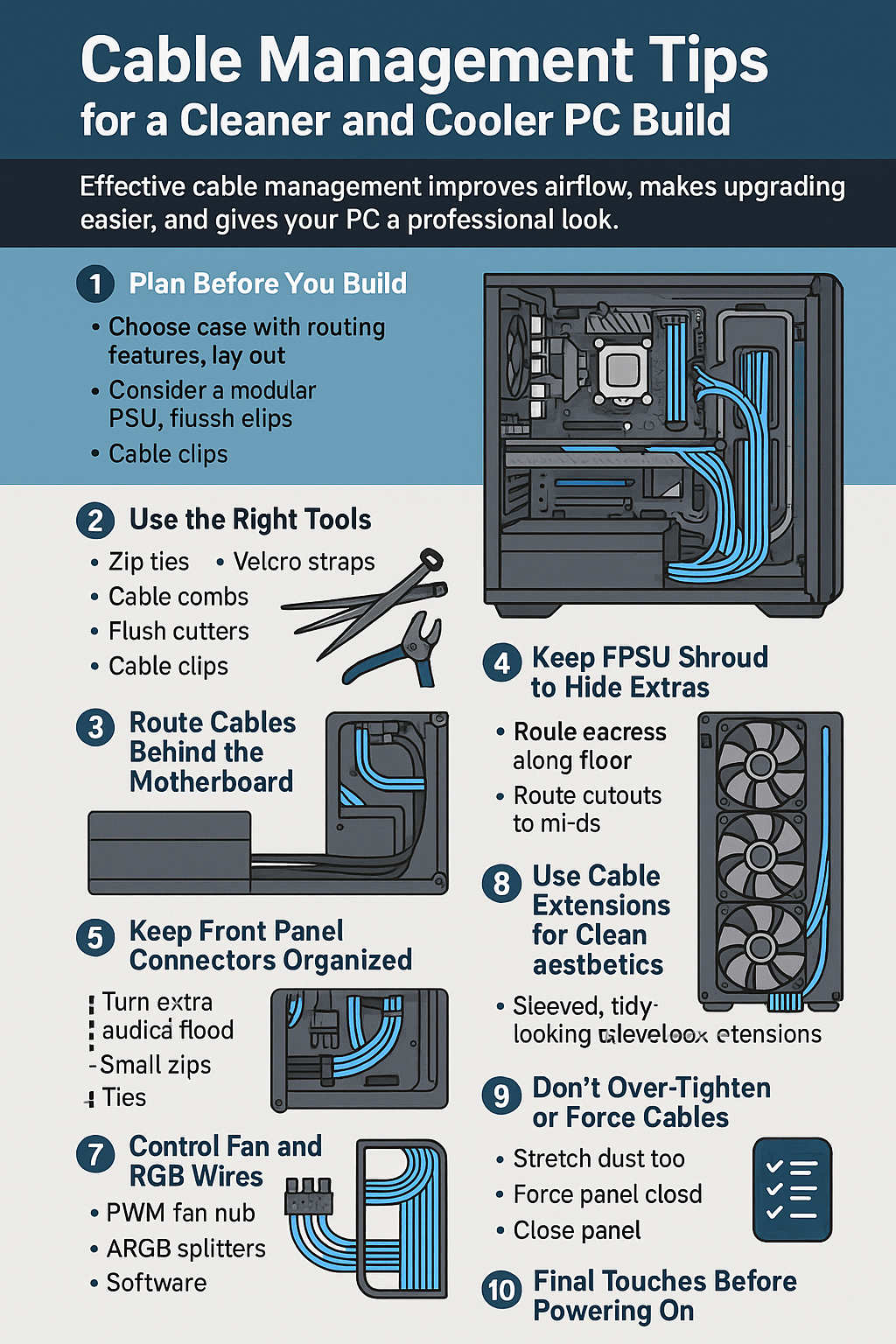Cable management isn’t just about making your PC look clean — it plays a big role in airflow, temperature, and maintenance. A well-managed system is easier to upgrade, quieter, and just more satisfying to work with.
In this guide, we’ll walk through the best cable management practices in 2025, covering tools, layouts, and step-by-step tips for beginners and enthusiasts alike.
Why Cable Management Matters
✅ Improves airflow and lowers temperatures
✅ Reduces dust buildup
✅ Easier to clean and upgrade later
✅ Prevents cable damage or tangling
✅ Makes your build look professional
Even if your case has no tempered glass, neat internals still matter for performance.
1. Plan Before You Build
Don’t wait until everything is plugged in.
🔹 Planning Tips:
- Choose a case with good cable routing features: grommets, tie-down points, PSU shroud
- Lay out components to understand where cables will run
- Pre-install cables like front panel headers and CPU EPS before placing the motherboard
- Consider using modular PSUs for cleaner builds
2. Use the Right Tools
| Tool | Purpose |
|---|---|
| Zip ties (plastic) | Bundling cables tightly |
| Velcro straps | Reusable and adjustable bundling |
| Cable combs | Neaten sleeved cables (GPU, 24-pin) |
| Cable clips | Guide cables across surfaces |
| Flush cutters | Trim excess zip tie length |
| Cable sleeves | Organize multiple cables together |
Tip: Most PC cases come with zip ties and Velcro straps included.
3. Route Cables Behind the Motherboard Tray
Modern PC cases have space behind the motherboard to hide and route cables.
🔹 Key Points:
- Route the 24-pin ATX cable, 8-pin CPU cable, SATA power, and fan/RGB headers behind the tray
- Use the provided tie-down points to secure the cables every few inches
- Keep cables flat against the tray to avoid panel bulge
4. Use the PSU Shroud to Hide Extras
If your case has a PSU shroud, use it to your advantage.
- Tuck unused cables under or inside the shroud
- Hide bulky adapters or excess length there
- Route fan/RGB hubs there too
5. Keep Front Panel Connectors Organized
Those small front panel connectors (power switch, reset, LEDs, audio) are annoying — but you can manage them.
- Group them together and run them along the case floor
- Use low-profile zip ties or small adhesive clips
- Consult your motherboard manual for exact pin layout to avoid reconnecting later
6. Manage GPU and CPU Power Cables
These are the most visible and thickest cables.
🔹 Tips:
- Route GPU PCIe cables from behind the shroud directly to the GPU
- Use cable combs for clean bends and symmetry
- For CPU 8-pin EPS, route through the top left cutout of your case
Avoid stretching cables over the GPU or CPU cooler.
7. Control Fan and RGB Wires
Fan and RGB cables can clutter your build quickly.
| Solution | What It Does |
|---|---|
| PWM fan hub | Central control for case fans |
| ARGB splitter/hub | Combines multiple RGB cables |
| Motherboard headers | Connect fans and sync lighting |
| Software control (iCUE, Armoury Crate) | Organizes RGB without extra hardware |
Route cables along case edges or under the motherboard tray.
8. Use Cable Extensions for Clean Aesthetics
Custom sleeved cable extensions let you keep your PSU hidden while upgrading your visible cables.
| Brand Examples | Features |
|---|---|
| AsiaHorse / Antec | Budget-friendly sets |
| CableMod | Premium, custom color kits |
| Thermaltake | RGB cable kits (for show builds) |
Match your build theme and improve the overall look.
9. Don’t Over-Tighten or Force Cables
- Leave a little slack in tight corners
- Avoid pulling on connectors
- Don’t force the back panel shut — reroute cables if needed
- Secure but don’t overtighten zip ties
10. Final Touches Before Powering On
- Double-check all power and fan connections
- Clean dust or fingerprints off the components
- Do a last visual pass for any loose or dangling cables
- Snap the side panels on gently — if it doesn’t close, fix the routing
Final Thoughts
Great cable management turns a good PC build into a great one. With some patience, planning, and the right tools, you can create a system that’s not only beautiful but also cool, quiet, and easy to maintain.
In 2025, cases and power supplies are designed with cable routing in mind — take full advantage of these features and enjoy the process of making your setup truly yours.
